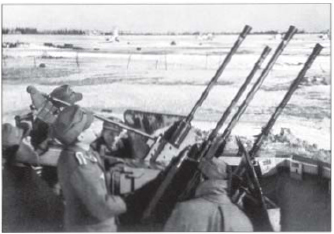
The Schirmmütze (peaked cap) had a grey-blue wool crown, black cotton band, and black leather or ‘Vulcanfiber’ peak. The enlisted ranks’ model had a patent leather chinstrap, and crown and band piping in the wearer’s Waffenfarbe (arm of service colour – see panel, page 16). Officers’ caps carried plaited chin cords and piping in silver-coloured (or gold-coloured for generals) wire thread, irrespective of branch. Insignia consisted of the Hoheitsabzeichen der Luftwaffe (air force national insignia), a flying eagle clutching the swastika; this surmounted the Mützenabzeichen (cap badge), a Reichskokarde (cockade) in national colours supported by Eichenlaubkranz und Schwingen (oakleaf garland and stylised wings). Both insignia were of stamped white alloy for enlisted ranks, woven silver-coloured wire for officers up to Oberst, and gold-coloured wire for generals (see Plates A1 & C2).
The Fliegermütze (flyer’s cap) was a simple grey-blue wool sidecap with a deep ‘curtain’ and rounded front and rear corners. A Hoheitsabzeichen, in white cotton thread for enlisted ranks and wire for officers, surmounted a slightly padded Reichskokarde woven onto grey-blue wool. Officers’ Fliegermützen were further distinguished by wire or ‘Celleon’ (cellophane) piping to the edge of the curtain and the circumference of the cockade (see Plates A2 & G1).
From 19 December 1938, Luftwaffe Gebirgs Dienst (mountain service) units received a grey-blue Bergmütze (mountain cap) with a short peak, emulating the Austrian-style cap of Gebirgsjäger (mountain riflemen) alongside whom they served. Its deep folded curtain could be lowered to protect the neck and ears in cold weather, with the single-button flap closure fastened beneath the chin (see Plate G2).

The effective quad-mounted 20mm Flakvierling 38 provides perimeter defence for an airfield in Russia, 1943; the crew’s headgear consist of Bergmützen and a Red Army ushanka worn by the gun-layer. The Flakartillerie arsenal ranged from light 20mm automatic and medium 37mm pieces, to the heavy 88mm, 105mm and 128mm Kanonen, including twin-mounted Flakzwilling types. The Flakartillerie managed to inflict a great deal of damage, despite derisive claims about their effectiveness from some fighter pilots. There were at first some grounds for such scepticism; for example, in the West during August and September 1942 only five USAAF bombers were lost to ground fire, compared to 26 claimed by fighters. By the end of June 1944, however, that gap had closed to a 50 per cent differential, with cumulative totals of 886 lost to Flak and 1,682 to fighters. Moreover, in the same period the numbers of US bombers damaged by artillery and fighters stood at 21,459 and 3,290 respectively. In 1944–45 the heavy concentrations of light guns around Luftwaffe airfields in NW Europe also took a much greater toll on low-flying Allied fighters than did the Jagdflieger.
On 11 June 1943, the Wehrmacht as a whole adopted the Einheitsfeldmütze 43 (M1943 universal field cap), itself inspired by the Bergmütze but with a longer peak and two-button flap closure. That issued to Luftwaffe personnel, the Einheitsfliegermütze 43, was of grey-blue wool with blue-painted alloy buttons (see Plate F1). Officers’ Bergmützen and Einheitsfliegermützen bore wire piping to the crown seam only (see Plate H1).
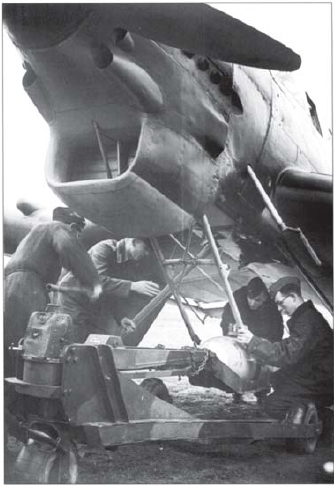
January 1939: an Oberfeldwebel assists ground crewmen in the transfer of an SC250 bomb from the hydraulic Bombenbeladewagen (bomb-loading trolley) into the Einhängung shackle of his Ju87A. The Stuka’s 80-degree dive usually commenced from 15,000ft, reaching up to 350mph; coloured lines etched across the windshield helped the pilot assess his angle to the horizon. At 7,000ft – about 30 seconds into the dive – a horn sounded and the pilot pressed a control column button to initiate the bombing sequence. The automatic recovery system began to pull the aircraft out of its dive and simultaneously released the bomb shackle at 3,000ft. The bomb was swung away from the fuselage and clear of the propeller, slipping free in perfect continuation of the line of descent. The aircraft continued to draw itself back to level flight, thus covering for any temporary loss of consciousness from G-forces, until the pilot could resume control. A ‘Stuka-Sirene’ was built into the undercarriage, generating its distinctive banshee wail; and ‘Jericho Trompeten’ – compressed cardboard flutes emitting a high-pitched whistle – were fitted to the fins of many aerial bombs. These effects helped to shred the already shaken nerves of defenders who found themselves helpless under tactical air attack.
A grey-blue Rock or Tuchrock (‘cloth tunic’) with four pleated pockets, turn-back cuffs, exposed four-button front and open collar, was adopted for everyday wear early in 1935. The enlisted ranks’ tunic had straight-edged pocket flaps, with patch breast pockets and expanding ‘bellows’ skirt pockets. It was lined in grey-blue cotton drill, incorporating an interior left breast pocket, Verbandstoff (wound dressing) pocket to the right front skirt, and short straps at the waist to accommodate belt-support hooks (see Plate C2).
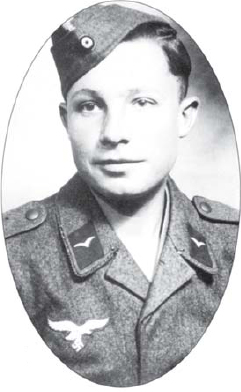
Flakartillerie Flieger Arnold Ortmann enlisted on 20 February 1943, yet his Fliegerbluse 40 retains collar piping in arm-of-service colour, officially abolished from 20 March 1940. The removable Kragenbinde (collar band) could be worn with most types of tunic; each man was issued two of these grey-blue and white cotton linings, just 10mm of which was to be visible, providing some comfort and protecting the tunic collar from wear. The second pattern breast eagle, with upswept tail, was adopted in 1936.
Officers were obliged to purchase a fine quality equivalent for everyday wear, usually tailored in wool tricot cloth with sateen or cotton lining. All pockets were of patch type, with straight or gently scalloped flaps (see Plate A1). Generous turn-back cuffs routinely served as document pockets. A lightweight white cotton version, prescribed as Sommeranzug (summer dress), comprised Sommerrock, straight Sommer- or Weisse Hose (white trousers) and white-topped Sommermütze with removable crown for ease of cleaning (see Plate E3). Although officially suspended at the outbreak of war, its continued purchase was in fact permitted.
The most distinctive item of Luftwaffe dress, the Fliegerbluse (flyer’s blouse), was developed concurrently for exclusive use as flying uniform. This short, close-fitting garment was simple and inexpensive to produce and quickly became the favoured tunic of all branches and on all occasions. The enlisted ranks’ Fliegerbluse 35 was without external pockets and bore no national badge (breast eagle). Five large ceramic or fibre buttons were concealed by a fly front, and a convertible collar with a small hook-&-eye enabled it to be fully fastened at the neck when necessary. It was partially lined with grey-brown cotton cloth, incorporating buttoned interior breast pockets, belt-hook support straps, and buttoned field dressing pocket. The cuffs could be tightened; a small woollen tab stitched to the inside of the cuff could be passed through a slit in the rear seam to an external button, or alternatively it could remain secured to an internal button.
Selection – not exhaustive – of ‘trade’ badges for enlisted ranks. Machine-embroidered in light grey thread on grey-blue cloth discs approx. 5.3cm in diameter, they were worn on the left forearm of tunics. Silvergrey cord edging indicated NCOs in some categories, e.g. (7); in others, seniority in grade – e.g. (23). Badge (19) was awarded after nine months’ service, but replaced by (25) from July 1937. Badge (22) was worn before qualification for metal aircrew badges – see Chart 3, page 44. Equipment administrators: (1) Admin NCO; (2) motor transport; (3) aircraft; (4) searchlight; (5) signals; (6) transport stores. Qualified personnel & operators: (7) Telephone; (8) teletype; (9) radio; (10) sound locator; (11) direction finder; (12) radio instructor; (13) signals personnel in non-LN units; (14) medical personnel; (15) MT driver; (16) air warning service; (17) a/c radio mechanic; (18) armourer, Flak; (19) gun crew, Flak; (20) ordnance, aerial munitions – light; (21) aerial munitions – heavy; (22) aircrew; (23) flight technical personnel; (24) sound locator crew, Flak; with Gothic ‘E’ instead of ‘H’ = range finder crew; (25) gun crew, Flak; gold cord edging denoted one year’s outstanding service or participation in destruction of enemy aircraft.
Officers’ Fliegerblusen were essentially similar but of finer quality cloth and fully lined with sateen or cotton; as with most items of officers’ kit, these privately purchased garments show many subtle variations in detail.
The upper part of the collars of both tunics bore edge-piping – Kragenlitze – in the appropriate Waffenfarbe for NCOs and enlisted ranks, silver for officers up to Oberst, and gold for generals. An order of 20 March 1940 discontinued the Waffenfarbe piping, but officers’ bullion piping was retained.
From 6 May 1940 pockets were added to the skirts of the Fliegerbluse. These were internally hung but, for NCOs and enlisted men, had large external flaps with rounded corners, fastened with exposed alloy buttons; for officers they were gently curved and flapless.
An order dated 1 October 1940 stated that the national eagle badge was to be fitted to the right breast of the Fliegerbluse, reflecting the garments’ elevation from work clothing to part of the Dienstanzug. Grey-blue ‘Kunstseide’ (rayon, synthetic silk) superseded cotton drill lining at the end of 1942, though the cut remained unaltered.
On 11 November 1938 a new dual-purpose tunic, the Waffenrock, had been approved as a replacement for both 1935 garments; this was identical to the Rock, except for a five-button front closure and convertible collar with concealed cloth tab and button ensuring a neat fit. The idea stood little chance against the popularity of the Fliegerbluse, however, and production ceased c.1940. A few Waffenröcke, usually privately tailored officers’ examples, remained in use until 1945.
Model 1935 Schulterklappen (shoulder straps) displaying the appropriate Waffenfarbe were sewn into the shoulder seams of other ranks’ Röcke and Fliegerblusen 35. They were routinely manufactured from scrap cloth generated during tunic production. This fixed design, a feature common to most Wehrmacht uniforms, soon caused supply problems and so, on 20 March 1940, removable versions were adopted by all services. Often produced by home-workers, Schulterklappen 40 were supplied directly to issuing stores in the desired Waffenfarbe. Tunics were consequently manufactured with a cloth stirrup and button to each shoulder, also simplifying production. The use of fixed Schulterstücke (shoulder boards) continued on officers’ Fliegerblusen and Röcke for smartness, although removable versions were available.
The status (i.e. officer, NCO or enlisted man), exact rank, and branch of service were identified on the collars of both tunics, with additional upper sleeve insignia for senior enlisted ranks. A special sequence of simplified upper sleeve rank patches were worn on flying clothing. Specialist qualifications for non-officer ranks were identified by badges on the lower (usually left) sleeve. Aircrew qualifications and accumulated mission awards were indicated by pin-on metal badges worn on the left breast. All the above will be found in Charts 1, 2 & 3.
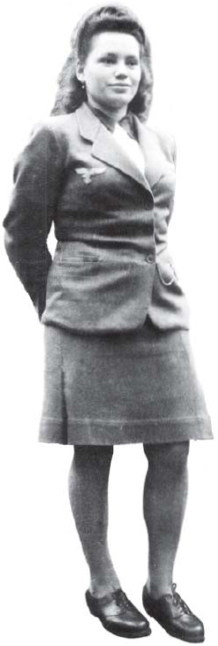
This Luftwaffe-Helferin wears Normalausstattung (standard uniform) adopted from 28 July 1941, comprising tailored Kostümjacke and Rock (skirt), although a dark undershirt is here worn instead of the regulation weisse Bluse. The Tuchmütze that completed this uniform copied the men’s Fliegermütze, but lacked the Reichskokarde. In addition to clerical tasks, Luftwaffe-Helferinen performed meteorological, telephone exchange, teletype and radio duties, and the majority worked in flight detection and plotting. A small number of women were also employed as airfield mechanics and ferry pilots. (Martin J.Brayley)
NCOs and other enlisted ranks were to have no undershirt visible with either tunic or blouse, and a white V-necked pullover Trikothemd (tricot shirt) was supplied. For parade dress and special occasions, including their own weddings, a Weiss Hemd (white shirt) and Schwarz Halsbinde (black necktie) were permitted. Officers wore the cotton Blaumeliertes Hemd (mixed blue, i.e. blue mixed with unbleached thread) with separate button-on collar for everyday wear. They were to provide themselves with white shirts for best dress. Officially, a black tie was to be worn at all times.
On 27 September 1943 a grey-blue Stoffhemd (cloth shirt) was approved for wear without a tunic in hot weather by all ranks. These were provided with shoulder strap fittings, a machine-woven breast eagle on a triangular backing of matching cloth, and large, pleated breast pockets with buttoned flaps. A grey-green version, originally adopted from 17 December 1943 for field units, became standard issue to all ranks and branches on 19 September 1944, and the grey-blue type was discontinued.
The straight grey-blue Tuchhose 35 issued to enlisted ranks incorporated slightly angled hip pockets, a buttoned slash pocket at the right rear, and a patch-type watch pocket to the right front; a rear V-notch and half-belt provided adjustment for the waistband. Some senior NCOs elected to wear Stiefelhose (breeches), with identical waist details. Officers’ Tuchhosen and Stiefelhosen were of superior cloth and tailoring; pocket openings tended to be vertically set, buckled waist adjustment tabs were provided at each hip, and the watch pocket was internal. The popular Reithose (riding breeches) were identical to Stiefelhose but with the addition of inner thigh reinforcement panels in matching cloth or, more often, contrasting stone-grey suede or moleskin (see Plate A1).
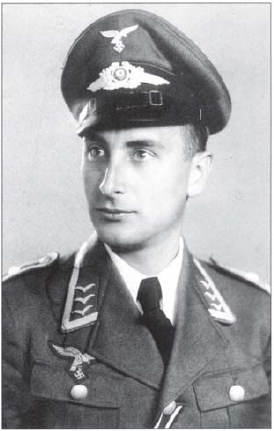
Nachrichten Feldwebel Gustav Clemen of Braünschweig, c.1940. His high quality privately tailored Rock has Waffenfarbe collar piping, and the silver braid Tresse of NCO ranks from Unteroffizier upwards. Note the well defined first pattern breast eagle (Hoheitsabzeichen), adopted from 1 March 1935 and styled after a Fliegerschaft design of 18 August 1934. As on most Wehrmacht open-collared tunics, this badge is placed to overlap the pocket flap and thereby avoid too much masking by the lapel. Clemen wears the Iron Cross 2nd Class ribbon.
The traditional high Schaftstiefel (shafted boot), or the Schnürschuhe (laced shoe) adopted from 13 March 1941 for economic reasons, were worn by enlisted ranks. Officers wore soft black leather riding boots with breeches, and low-quarter black shoes with straight trousers.
A mid-calf length grey-blue wool Übermantel 35 completed the main uniform issue. The double-breasted coat had two rows of six standard Gekörnte-Knöpfe (pebbled finish buttons) to the front, slanted hip pockets with buttoned flaps, and turned-back cuffs. A rear half-belt provided adjustment and, when unfastened, allowed the deep-pleated coat to double as a blanket. Small metal hooks and thread loops permitted the skirts to be folded back to the hips, easing marching, but this was dropped during 1940, when the alloy buttons were also painted grey-blue. Shoulder straps and collar patches were worn on the overcoat, but the latter were officially abolished on 29 May 1942 (see Plate E1).
Fine quality officers’ overcoats were usually lined with sateen cloth and, while details varied according to taste and budget, all were required to incorporate supports and access slit under the left pocket flap to attach the sword or dress dagger when appropriate.
The blanket-lined Einheitlicher-Tuchmantel (universal cloth overcoat) with enlarged collar, detachable hood and vertical hand-warmer torso pockets was approved on 17 October 1942.